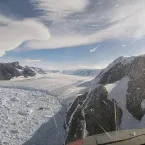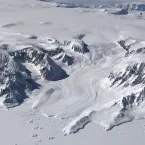
Ice Sheets Today
Melt Analyses
Our scientific data analysis articles for the Greenland Ice Sheet melt season are typically published from April 1 to November 1. Antarctic Ice Sheet melt season articles are published from November 1 to April 1. Select an article below to explore ice sheet melt conditions by month and year-to-date.




Surface melting on the Greenland Ice Sheet is on a slightly above-average track for the 2025 melt season, with melt along the western coast leading the way.




Melt events on both sides of the Antarctic Peninsula and along the Dronning Maud coastal ice shelves between December 15 and 19 combined to produce an early-season record melt extent of just below 2 percent of the Antarctic Ice Sheet for December











